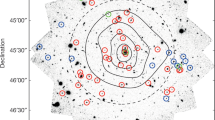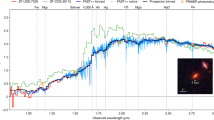Abstract
Blue compact galaxies (BCGs) are characterized by their compact appearance and very blue colours1,2 indicative of a high star-formation rate. The metal abundances are low, suggesting that the present rate of star formation cannot have lasted for very long3 (unless the gas is being replenished). These galaxies are thus either truly young or their star formation takes place in short bursts3,4. ESO400-G43 ( = 2034–356) is one of the brightest and largest BCGs known. Observations in the 21-cm line with the Very Large Array (VLA) of the National Radio Astronomy Observatory reveal a massive (5×109 M⊙) slowly rotating H I halo. Optical observations obtained at the European Southern Observatory (ESO) show that the morphology and spectral properties are consistent with a predominantly young stellar population and an extremely low mass to light ratio (M/LB = 0.1). The luminous stars seem to be concentrated in a rapidly spinning central disk. Dark matter is dominating the mass at large radii.
This is a preview of subscription content, access via your institution
Access options
Subscribe to this journal
Receive 51 print issues and online access
$199.00 per year
only $3.90 per issue
Buy this article
- Purchase on Springer Link
- Instant access to full article PDF
Prices may be subject to local taxes which are calculated during checkout
Similar content being viewed by others
References
Sargent, W. L. Astrophys. J. 160, 405–427 (1970).
Sargent, W. L. & Searle, L. Astrophys. J. 162, L155–L160 (1970).
Searle, L. & Sargent, W. L. Astrophys. J. 173, 25–33 (1972).
Gerola, H. & Seiden, P. E. Astrophys. J. 223, 129–139 (1978).
Wade, R. A., Hoessel, J. G., Elias, J. H. & Huchra, J. P. Publs. astr. Soc. Pacif. 91, 35–40 (1979).
Rosa, M. The Messenger 39, 15–17 (1985).
Gordon, D. & Gottesman, S. T. Astr. J. 86, 161–177 (1981).
Bergvall, N. & Olofsson, K. Astr. Astrophys. Suppl. 64, 469–476 (1986).
Humphreys, R. M. & McElroy, D. B. Astrophys. J. 284, 565–577 (1984).
Salpeter, E. E. Astrophys. J. 121, 161–167 (1955).
Young, J. S., Schloerb, F. P., Kenney, J. D. & Lord, S. D. Astrophys. J. 304, 443–458 (1986).
Author information
Authors and Affiliations
Rights and permissions
About this article
Cite this article
Bergvall, N., Jörsäter, S. ESO400-G43, a forming galaxy?. Nature 331, 589–591 (1988). https://doi.org/10.1038/331589a0
Received:
Accepted:
Issue Date:
DOI: https://doi.org/10.1038/331589a0
This article is cited by
-
An observational constraint on the existence of proto-superclusters at z =3.3
Journal of Astrophysics and Astronomy (1990)
-
HI observations ofHII-galaxies
Astrophysics and Space Science (1989)
Comments
By submitting a comment you agree to abide by our Terms and Community Guidelines. If you find something abusive or that does not comply with our terms or guidelines please flag it as inappropriate.



